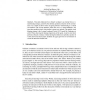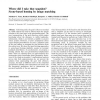13 search results - page 1 / 3 » Visual homing in environments with anisotropic landmark dist... |
AROBOTS
2007
13 years 5 months ago
2007
Gradient descent in image distances can lead a navigating agent to the goal location, but in environments with an anisotropic distribution of landmarks, gradient home vectors devia...
DAGSTUHL
2003
13 years 6 months ago
2003
Abstract. This study illustrates how obstacle avoidance can emerge from a visual homing strategy, caused by the intrinsic geometric structure of the environment. An example is show...
IROS
2006
IEEE
13 years 11 months ago
2006
IEEE
— Current approaches to the visual homing for mobile robot navigation are generally inspired in insects’ behavior and based on the observed angular information of fixed points...
BC
1998
13 years 4 months ago
1998
In homing tasks, the goal is often not marked by visible objects but must be inferred from the spatial relation to the visual cues in the surrounding scene. The exact computation o...
PRESENCE
2002
13 years 4 months ago
2002
The literature often suggests that proprioceptive and especially vestibular cues are required for navigation and spatial orientation tasks involving rotations of the observer. To ...


